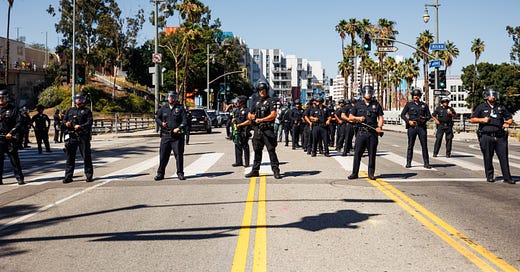The violence and incitement are coming from Trump
Words & Phrases We Could Do Without
Donald Trump twists language, as do all autocrats, to cast himself and his cult as victims, whereas his dissenters are violent, rebellious, and threatening. In the real world, however, we have seen Trump repeatedly provoke violence rather than take any measures to prevent it. Indeed, he has historically encouraged rather than condemned violent supporters.
The president deliberately confuses “violence” with “protest,” and “rebellion” with “demonstrations.” He insisted in his memorandum nationalizing the California National Guard and deploying the Marines that he holds the power to deploy forces anywhere in the U.S. where protests are or are likely to occur. He later threatened to use “heavy force” against protestors who showed up at his sparsely attended birthday parade.
This all feeds into a pattern. When Trump called for his mob to charge the Capitol on Jan. 6 or egged on the crowd chanting “Hang Mike Pence,” he was inciting violence. As Gov. Gavin Newsom remarked to Californians, “Trump—he’s not opposed to lawlessness and violence, as long as it serves HIM. What more evidence do we need than January 6th?” When Trump pardoned violent insurrectionists, he established an approval structure that encouraged other acts of violence (be they in Minnesota, Utah, or Culpepper, Va.)
When Trump sent Marines and the National Guard into a relatively calm city, that was “incitement.” He was spoiling for a fight to justify more repression and state terror against ordinary workers whom he has demonized and dehumanized. And when he vowed to step up raids of masked ICE agents in Democratic cities, he was threatening to incite more violence.
Trump consistently tries to use opponents’ imaginary violence to justify the use of force. However, U.S. District Court Judge Charles Breyer of the Northern District of California debunked the government’s claimed authority to deploy force in anticipation of a “rebellion”:
[T]he Court is troubled by the implication inherent in Defendants’ argument that protest against the federal government, a core civil liberty protected by the First Amendment, can justify a finding of rebellion. The [Supreme Court cases] are chock-full of language explaining the importance of individuals’ right to speak out against the government—even when doing so is uncomfortable, even when doing so is provocative, even when doing so causes inconvenience….
Applying these principles, courts have repeatedly reaffirmed that peaceful protest does not lose its protection merely because some isolated individuals act violently outside the protections of the First Amendment.
Breyer reaffirmed that preempting or preventing First Amendment expression on the speculation that violence might occur is verboten under the First Amendment. “In short, individuals’ right to protest the government is one of the fundamental rights protected by the First Amendment, and just because some stray bad actors go too far does not wipe out that right for everyone,” Breyer wrote. “The idea that protesters can so quickly cross the line between protected conduct and ‘rebellion against the authority of the Government of the United States’ is untenable and dangerous.”
Now, even core First Amendment speech is enough to set off a MAGA crackdown. MAGA authoritarians suggest the standard for use of force against peaceful Americans is so low that even “failing to show deference” to the regime is sufficient cause to trigger government violence, as the Department of Homeland Security claimed after manhandling Sen. Alex Padilla (D-Calif.) When the temerity of voicing dissent is sufficient to trigger a violent government crackdown, we should be clear which side has resorted to violence.
Trump appears “eager to create optics that support his claim that public dissent constitutes an existential threat to the nation,” writes Ruth Ben Ghiat. She adds that Trump, in true authoritarian style, uses various methods: “Flooding our screens with images that habituate us to a new reality of federalized state militia members standing opposite civilian protesters is part of it. So is mobilizing our armed forces for a parade staged on Mr. Trump’s birthday.” This is about intimidation, crushing dissent, and brute force. Trump’s characterization of protestors has nothing to do with their actual conduct, and everything to do with whether they are on his side. Whoever does not conform to his dictates is fair game for the strongman’s violence.
In sum, Trump has defiled ordinary language (“preventative,” “rebellion”). He mischaracterizes protests as “violence” or “riots,” and falsely adopts the mantle of “restoring law and order.” Those words have lost any semblance of meaning under his regime. Instead of adopting his descriptions, we must acknowledge that Trump actions fit the playbook of fascists, who instrumentalize violence to crack down on opposition. Trump wants to prevent dissent, and will use violence to accomplish his means. He wants to provoke and incite a violent response, leaving him with justification to crush his opponents.
If that sounds like the death knell of democracy, it is. Thankfully, millions of people peacefully demonstrated on Saturday that they know what the First Amendment allows, and do not intend to let Trump get away with inflicting violence on our Constitution or brutalizing fellow Americans.






Thank you for putting the blame where it belongs. I watch newscasters talk about the rise in political violence and wonder why. Well, we know exactly why. You just said the answer out loud that others haven’t.
Right on, Jen! MAGA has always been ready to violently attack anyone who doesn’t kowtow to their dear leader. It’s mind boggling that so many Americans can be convinced that the Republican Party is anything but a rogue organization made up of sycophantic thugs ready to do the violent bidding of dear leader. What is astonishing is that regular folks think so highly of the criminal who has hijacked the once venerable party.